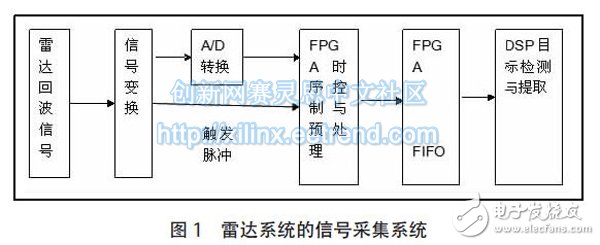In recent years, radar has achieved tremendous development in both military and civilian applications. The radar signal processing system is a key module of the radar and plays a decisive role in radar positioning accuracy. FPGAs are widely used in radar signal processing systems for their many advantages. This article explores the application of FPGAs in radar signal acquisition.
Under the condition that the conversion rate of today's high-speed A/D conversion circuits is getting higher and higher, the radar system puts higher requirements on the processing rate of the digital signal processor. Traditional general-purpose DSPs sometimes cannot directly process the ultra-high-speed data streams generated by sampling due to the limitation of their operating speed. The application of FPGAs in radar systems brings economic and effective solutions to the above problems [1].
First, the main technology of radar signal processing and the characteristics of FPGAThe main steps of signal processing in radar signal processing system are: radar signal mode conversion and storage → target detection and signal processing → data transmission with upper computer → host computer target display and control, the main technology involved is data resampling , adaptive filtering, pulse compression, parameter estimation, constant false alarm processing, adaptive beamforming, etc. These steps require highly repetitive FFT, FIR and other operations, and the real-time requirements are extremely high. FPGAs, or field-programmable gate arrays, contain look-up tables, multiplexers, registers, and memories, as well as dedicated circuits such as multipliers, fast adders, and input-output processing units. Now the data processing capability of FPGA has far surpassed that of CPU and DSP, and it has gradually become a key module in the field of large data processing such as digital communication, video and image codec, and high-performance digital signal processing system [2]. In summary, FPGAs are suitable for use in radar digital signal processing systems.
Second, the radar signal acquisition and analysisIn the process of radar system signal acquisition, the task that needs to be completed is to digitally collect the radar echo analog signal, how to achieve digital acquisition, which includes how to set the sampling frequency, whether the sampling is accurate, and whether all information can be retained. Signal processing problems such as the original signal and how much synchronization error [3]. Since the radar video signal is an analog video signal, it is necessary to digitally collect the radar video signal. First, the timing digital logic circuit composed of the FPGA is used for sampling, and the original radar analog signal is converted into a digital signal that the system can process [4]. The sampled digital signal is then transmitted to a subsequent module for further processing. There are usually two types of radar signals, Nyquist sampling and oversampling.
Nyquist sampling: When the sampling frequency is greater than or equal to twice the maximum frequency of the sampled analog signal, the sampled signal obtained after sampling the analog signal can retain all information, thereby reducing the original analog signal. From Nyquist sampling, it can be seen that there is a minimum undistorted sampling frequency fs that is twice the maximum frequency of the original analog signal, called the Nyquist sampling frequency. The general analog signal will not be the ideal band-limited signal, so the aliasing phenomenon of the spectrum often occurs. For this reason, an effective method in practice is to filter the analog signal through low-pass filtering before sampling.
Third, the design of radar signal acquisition system based on FPGAThe radar system signal acquisition module first transmits the digital signal obtained by the A/D conversion of the analog signal to the FPGA together with the timing trigger pulse, and the FPGA uses its programmable logic gate circuit to realize the digital signal acquisition, and generates the control signal and address. The signal is then stored in the first-in-first-out queue of the FPGA, and communicated with each other through the communication interface and the digital signal processor (DSP) to facilitate the subsequent signal processing and information display, and the signal acquisition module thereof Figure 1 shows:

In the designed radar system signal acquisition module, the main task of the FPGA is to complete the digital acquisition of the analog signal. The FPGA works as follows: (1) Control the digital-to-analog conversion chip to ensure the collected radar echo signals. quality. (2) Combine the collected digital data and transmit it to the digital signal processor (DSP) to prepare for the next signal processing and information display.
Fourth, summaryDigital acquisition of radar signals is an extremely important technology in radar signal processing systems. With the development of digital technology, the digital acquisition of modern radar signals mainly relies on digital technology. This paper is based on FPGA to explore the method of radar signal processing. Based on the analysis of the FPGA computing power, it makes full use of its advantages and uses it to complete the digital acquisition of signals.
Comcn Electronics Limited , https://www.comencnspeaker.com